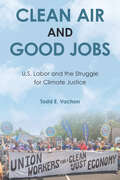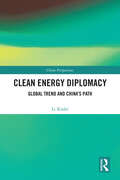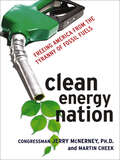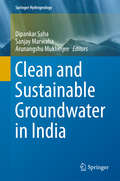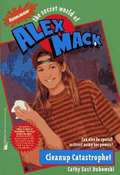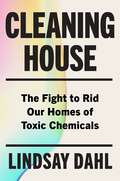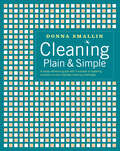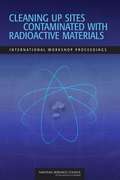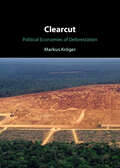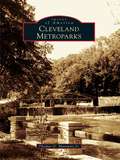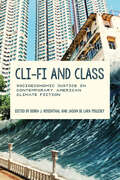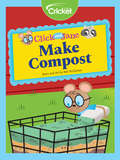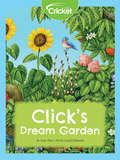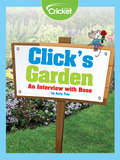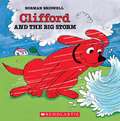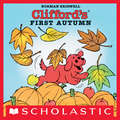- Table View
- List View
Clean Air and Good Jobs: U.S. Labor and the Struggle for Climate Justice
by Todd E. VachonThe labor–climate movement in the U.S. laid the groundwork for the Green New Deal by building a base within labor for supporting climate protection as a vehicle for good jobs. But as we confront the climate crisis and seek environmental justice, a “jobs vs. environment” discourse often pits workers against climate activists. How can we make a “just transition” moving away from fossil fuels, while also compensating for the human cost when jobs are lost or displaced? In his timely book, Clean Air and Good Jobs, Todd Vachon examines the labor–climate movement and demonstrates what can be envisioned and accomplished when climate justice is on labor’s agenda and unions work together with other social movements to formulate bold solutions to the climate crisis. Vachon profiles the workers and union leaders who have been waging a slow, but steadily growing revolution within their unions to make labor as a whole an active and progressive champion for both workers and the environment. Clean Air and Good Jobs examines the “movement within the movement” offering useful solutions to the dual crises of climate and inequality.
Clean Air and Good Jobs: U.S. Labor and the Struggle for Climate Justice
by Todd E. VachonThe labor–climate movement in the U.S. laid the groundwork for the Green New Deal by building a base within labor for supporting climate protection as a vehicle for good jobs. But as we confront the climate crisis and seek environmental justice, a “jobs vs. environment” discourse often pits workers against climate activists. How can we make a “just transition” moving away from fossil fuels, while also compensating for the human cost when jobs are lost or displaced? In his timely book, Clean Air and Good Jobs, Todd Vachon examines the labor–climate movement and demonstrates what can be envisioned and accomplished when climate justice is on labor’s agenda and unions work together with other social movements to formulate bold solutions to the climate crisis. Vachon profiles the workers and union leaders who have been waging a slow, but steadily growing revolution within their unions to make labor as a whole an active and progressive champion for both workers and the environment. Clean Air and Good Jobs examines the “movement within the movement” offering useful solutions to the dual crises of climate and inequality.
Clean Energy Diplomacy: Global Trend and China's Path (China Perspectives)
by Li XinleiThis book systematically constructs theories of clean energy diplomacy in the context of the changing international strategic landscape of energy and climate. It aims to explain the scientific connotations and innovative significance of clean energy diplomacy. The book focuses on analyzing how the development of renewable energy, including wind, solar, and biomass, plays out in the evolution of the international power system. It also touches upon energy efficiency and complementary energy technologies. This book integrates the studies of traditional energy and environmental diplomacy and defines its connotations and extensions from the perspective of major country diplomatic strategy. Based on the latest developments of international clean energy diplomacy, the author also discusses China's strategic option of clean energy diplomacy in the broad context of the profound changes in global energy and climate governance. As a new diplomatic model to enhance national competitive advantages, clean energy diplomacy has attracted the attention of many countries. This book will therefore be of great interest to students and scholars of sustainable energy and environmental management, environmental politics and policy, and those interested in the low-carbon economy in general.
Clean Energy Nation: Freeing America from the Tyranny of Fossil Fuels
by Martin Cheek Jerry McNerneyIn the vein of “An Inconvenient Truth,” a sobering assessment of our nation’s energy policies and a stirring call for change. Dangerous CO2 emissions, massive oil spills, dwindling supplies—the problems with fossil fuels are driving a long-overdue reassessment of our nation’s energy policies. U.S. Congressman Jerry McNerney, a renewable energy engineer and the first representative with expertise in energy independence, leads the way to change. In Clean Energy Nation, he and journalist Martin Cheek make an impassioned argument for drastically reducing dependency on fossil fuels and developing sustainable, readily available energy sources—solar, wind, biofuel, geothermal, and hydrogen-based power. Bringing together a rare combination of scientific knowledge, political savvy, and insightful journalism, the authors reveal the pros and cons of alternative energy sources and examine how our nation became addicted to fossil fuels in the first place. The book reads like the dramatic story it is, complete with dire projections about peak oil and grim scenarios of rising oceans…keen insights into policies and players that have stalled progress on climate change and favored big oil…and astute recommendations for building a clean energy economy and a prosperous, stable future.
Clean Power Politics
by Joseph P. TomainThe United States has been experiencing an energy transition for over four decades, and now - thanks to the Clean Power Plan of the Obama Administration and the Paris climate agreement - a clean energy future is moving closer to reality. In Clean Power Politics, Joseph Tomain describes how clean energy policies have been developed and, more importantly, what's necessary for a successful transition to a clean energy future, including technological innovation, new business models, and regulatory reforms. The energy system of the future will minimize the environmental costs of traditional energy production and consumption, and emphasize expanded use of natural resources and energy efficiency. Because many new energy technologies can be produced and consumed at smaller scales, they will shift decision-making power away from traditional utilities and empower consumers to make energy choices about consumption and price. In this way, a clean energy future embodies a democratization of energy.
Clean Water: Next Generation Technologies (Advances in Science, Technology & Innovation)
by Ahmad Fauzi Ismail Mohamed Mehdi Chehimi Mehmet A. Oturan Khouloud JlassiThis book summarises the recent, and future, sustainable, low-cost, environment-friendly and efficient systems for clean water production, to solve clean water crisis. We cover production of water the dew and rain or via desalination, Fenton processes or electrocoagulation; nanomaterial-based water purification methods including adsorption, catalysis, smart-sensors for pollutants detection and removal. We also cover environmental management, environmental policy aspects, and review recent patents and industrial processes to produce clean water. Written by experts in the domain of wastewater treatment, production of clean water and environmental management, this new book will be a unique tool for experts and students. We anticipate it open new horizons in clean water production and will be a source of inspiration for next generations of clean water technologies researchers
Clean and Green Energy (Green Earth Science Discovery Library)
by Colleen HordYoung Readers Will Discover What Types Of Energy Are Clean And Have Less Impact On The Environment.
Clean and Sustainable Groundwater in India (Springer Hydrogeology)
by Dipankar Saha Sanjay Marwaha Arunangshu MukherjeeThe book embodies the groundwater issues and challenges in India focusing its sustainable use. It is a compilation of papers presented by the eminent experts from Government departments, academia, research institutes, NGOs and stakeholders who assembled at Kurukshetra on 21st August, 2015 in the event of Bhujal Manthan or "Churning of Groundwater" organized for the first time by Ministry of Water Resources, River Development and Ganga Rejuvenation, the apex Ministry of Water Resource under Government of India. India, as a country, is the highest groundwater extractor in the world. Its service towards attaining the food and clean drinking water security is well documented. This volume addresses the issues of aquifer characterization, groundwater contamination, groundwater resource availability and its sustainable management through community participation in pan-India scenario. This book provides a unique opportunity for its readers to understand groundwater domain in India in its entire gamut. The papers included in the volume were selected carefully from the presentations made in the following four broad topics during the Manthan; (i) groundwater quality, (ii) conjunctive use of surface and groundwater, (iii) management intervention and sustainable use of this resource, and (iv) groundwater problems and application of various techniques. The book contains 20 papers including an introductory chapter by the editors. The content of the book is enriched by contributions from eminent researchers and activists in groundwater domain, like Prof. Tushar Shah, Prof. Himanshu Kulkarni, Dr. D. K. Chadha, Dr. Bharat Sharma and others. The recommendations in the individual papers are of immense significance for keeping the groundwater of the country clean and sustainable. The volume will help the readers to understand the groundwater issues of the country and also assist policy makers to prepare strategies for its better governance and management with environmentally sustainable ways.
Clean-up Catastrophe! (The Secret World of Alex Mack #6)
by Cathy East DubowskiIt's Alex's chance to organize her schoolmates to do a community cleanup project, win the prize and show everybody how special she is. She is so hard on her friends that they go to the competitor. Now she has to use her powers.
Cleaning House: The Fight to Rid Our Homes of Toxic Chemicals
by Lindsay DahlFrom the front lines of the movement for safer products, environmental health expert Lindsay Dahl takes us on her journey from skeptic to activist, exposing the secret forces that keep toxic chemicals in our homes, bodies, and environment—showing us how to fight back and keep our families safe.In Cleaning House, Lindsay Dahl shows how seemingly innocuous items—everything from toys to common beauty and cleaning products—can include toxic chemicals, thanks to a consistent failure of regulation in the United States. The scientific research linking toxic chemicals in products to rising rates of cancer and reproductive harms is as strong as the science that led to banning lead from gasoline, PBCs, and DDT. But with varying degrees of protective guardrails in place for the everyday items, consumers are tasked with playing toxic-chemical detective and those unable to afford safer products are left hanging in the balance. Through vivid storytelling and robust scientific evidence, Dahl makes a compelling case that a safer world will only arrive through systemic change. We must turn off the tap of toxic chemicals before they make their way into our homes and bodies—and here she shows you how. Drawing on Dahl’s extensive experience as a lobbyist, product formulator, and a parent, she unravels the shocking web of political and cultural factors that landed us here and are key to solving this massive public health crisis. Dahl takes readers behind the scenes as a young but determined lobbyist fighting powerful chemical industry players, which she discovered are replicating Big Tobacco’s disinformation playbook by downplaying the harms of the toxic chemicals they continue to profit from. And she introduces readers to the brilliant scientists doing ground-breaking research, legislators passing life-saving laws, forward-thinking business leaders, communities facing the highest level of exposure to toxic chemical pollution, and parents from all political stripes who have joined the fight for a safer world. Told through a compelling David and Goliath narrative, Cleaning House dares to take a pragmatic and science-based approach to the concept of clean living, in a time where the wellness movement is threatened by partisan politics and misinformation. It is an essential read for anyone who wants a safer home and a safer future for our children.
Cleaning Plain & Simple: A Ready Reference Guide with Hundreds of Sparkling Solutions to Your Everyday Cleaning Challenges
by Donna SmallinLearn how to clean smarter, not harder, and you&’ll have more time to do the things you love. With plain and simple advice on everything from dusting and swabbing to polishing and vacuuming, best-selling author Donna Smallin shows you how to make the most of your valuable cleaning time. Hundreds of quick tips and practical solutions for every imaginable cleaning situation promise you the sparkling, healthy environment you want for your family. This publication conforms to the EPUB Accessibility specification at WCAG 2.0 Level AA.
Cleaning Up Sites Contaminated With Radioactive Materials: International Workshop Proceedings
by National Research Council of the National AcademiesThis publication features papers presented at the Workshop on Cleaning Up Sites Contaminated with Radioactive Materials, held in Moscow in June 2007. This activity was organized by the National Academies in cooperation with the Russian Academy of Sciences and with funding provided by the Russell Family Foundation. The workshop was designed to promote exchanges of information on specific contaminated sites in Russia and elsewhere and to stimulate greater attention to the severity of the problems and the urgent need to clean up sites of concern to the local and international communities.
Clearcut: Political Economies of Deforestation
by Markus KrögerRegionally dominant extractive sectors - including Brazilian cattle ranching, Amazonian narco-gold mining, and Finnish paper pulping - provide the foundation for this book's analysis of the range of motivations for deforestation. This framing allows for a discussion of the global political economy and ecology in general, and an in-depth examination of the varieties of extractivisms that define land and resource use. The chapters take an interdisciplinary approach, drawing on political ethnography and world systems analyses across the Global North-South divide. The book develops and applies a new theory that identifies regionally dominant political-economic systems as the driving forces behind deforestation. This book is essential reading for advanced students, researchers, and policy makers working in (de)forestation, environmental studies, environmental law, economics, conservation, climate change, and sustainability, leading to a deeper understanding of why our planet's forests are under threat. This title is also available as Open Access on Cambridge Core.
Clearing the Global Health Fog
by Olusoji Adeyi Thyra De Jongh Kelechi Ohiri Federica V. Secca Rifat AtunA longstanding debate on health system organization relates to the benefits of integrating programs that emphasize specific interventions into mainstream health systems to increase access and improve health outcomes. This debate has long been characterized by polarization of views and ideologies, with protagonists for and against integration arguing relative merits of each approach. Recently, the debate has been rekindled due to substantial rises in externally-funded programs for priority health, nutrition, and population (HNP) interventions and an increase in international efforts aimed at health system strengthening. However, all too frequently these arguments have not been based on hard evidence. In this book we present findings of a systematic review that explores a broad range of evidence on: (i) the extent and nature of integration of targeted health programs that emphasize specific interventions into critical health systems functions; (ii) how the integration or non-integration of health programs into critical health systems functions in different contexts have influenced program success; and (iii) how contextual factors have affected the extent to which these programs were integrated into critical health systems functions. The findings provide a new synthesis of evidence to inform the debate on health systems and targeted interventions. In practice a rich mix of solutions exists. While the discussion on the relative merits of integrating health interventions will no doubt continue, discussions should move away from the highly-reductionist approach that has polarized this debate.
Cleveland Metroparks
by Thomas G. Matowitz Jr.A century ago, William A. Stinchcomb, aged 27, closed his annual report as chief engineer of parks for the City of Cleveland with a challenge to create an outer ring of parks and boulevards to benefit all residents of Greater Cleveland. By 1912, legislation authorizing it had been enacted, and three acres of land were acquired through a donation. This formed the nucleus of the vast park system that now includes almost 21,000 acres. Cleveland Metroparks has provided generations of area residents with readily accessible facilities for year-round recreation. The park provides opportunities for hiking, horseback riding, swimming, cycling, golfing, and boating. Use of the park, which crosses the boundaries of approximately 48 communities in the Cleveland area, has become a tradition for many families.
Cleveland School Gardens (Images of America)
by Joel MaderThe Cleveland Public School's tract garden program was one of the most successful and innovative programs of the school system. The organization and beauty of the gardens attracted horticulture educators from all over the United States, South America, and as far away as Japan. From its humble beginnings in 1904 as a project to beautify vacant lots in Cleveland, it grew into an educational tool that taught thousands of children the respect for nature and its bounty. At the tract gardens' height, the amount of land under cultivation in the middle of the Cleveland urban landscape approached 100 acres. By 1970, there were 27 horticultural centers servicing all Cleveland schools. Centers were located next to schools, in housing estates, at fairgrounds, at a home for the aged, and on museum property. A few of the centers are now neighborhood gardens. The photographs in Cleveland School Gardens show that the Cleveland Public Schools knew the importance of being "green" 100 years before it was politically fashionable.
Cli-Fi and Class: Socioeconomic Justice in Contemporary American Climate Fiction (Under the Sign of Nature)
by Adam Trexler Matthew Schneider-Mayerson Magdalena Maczynska Andrew Milner Lisa Ottum Martín Premoli B. Jamieson Stanley Jessica Cory Jennifer Horwitz Professor Jennifer Schell Kimberly Bain Jeffrey M. Brown Teresa GodduSince its emergence in the late twentieth century, climate fiction—or cli-fi—has concerned itself as much with economic injustice and popular revolt as with rising seas and soaring temperatures. Indeed, with its insistent focus on redressing social disparities, cli-fi might reasonably be classified as a form of protest literature. As environmental crises escalate and inequality intensifies, literary writers and scholars alike have increasingly scrutinized the dual exploitations of the earth&’s ecosystems and the socioeconomically disadvantaged. Cli-Fi and Class focuses on the representation of class dynamics in climate-change narratives. With fifteen essays on the intersection of the economic and the ecological—addressing works ranging from the novels of Joseph Conrad, Cormac McCarthy, and Octavia Butler to the film Black Panther and the Broadway musical Hadestown —this collection unpacks the complex ways economic exploitation impacts planetary well-being, and the ways climatic change shapes those inequities in turn.
Click and Jane: Desert Life
by Rob McClurkanWhat animals do you think live in the desert? Follow Click and Jane as they travel through the desert. Not believing anything can live in the hot, dry desert, Click quickly learns that plenty of creatures make their homes in the desert. As the pair is introduced to different birds, plants, reptiles, coyotes, and owls, Click and Jane are able to come to appreciate the desert. The two continue their journey as they help the desert animals plan a pool party—the only problem is that the pool doesn’t have any water!
Click and Jane: Make Compost
by Rob McClurkanMaking a compost pile is a simple way to dispose of waste—like leaves, grass clippings, fruit, and vegetable peels—and turns them into healthy food for plants! Cece notices how nice Jane’s flowers are and wants to make a compost pile, too! Jane and Click show their friends how to make compost and you can learn too! What else is needed to help the compost decompose?
Click and the Kids: Hike Through the Forest
by Betsy Page BrownMartin, Liz, and their friend take a hike through the forest and learn about animals and plant life. This forest ecosystem is a healthy environment for animals and plant life to grow. A woodpecker checks for bugs to eat in a nearby tree, with bark that is ancient. Martin notices moss on the old tree bark and poisonous mushrooms! What else will they find on their forest hike?
Click's Dream Flower Garden
by Carol Schwartz Amy TaoClick loves flowers! If he could have anything he wanted in his garden, he would choose flowers with a variety of different seeds, bulbs, leaves, and stems so he could enjoy all sorts of pretty colors and interesting plants! Did you know that orange blossoms turn into fruit, or that a pussy willow’s flowers are called a catkin? Follow along with Click and learn all sorts of cool flower stuff!
Click's Garden: An Interview with Rose
by Amy TaoClick the mouse learns all about plants from his garden flower, Rose.
Click, Clack, Splish, Splash: A Counting Adventure (A Click Clack Book)
by Doreen Cronin Betsy Lewin<p>Duck is about to trick poor Farmer Brown once again. While the farmer is sleeping the afternoon away, Duck and the other animals are planning a most unusual fishing trip. Sneaking past Farmer Brown is going to be as easy as 1, 2, 3! <p>This numerical adventure for the very youngest Duck fans brings counting books to a whole new level -- click, clack, splish, splash!</p>
Clifford And The Big Storm
by Norman BridwellThe most popular big, red, lovable dog that ever was! Clifford books have sold millions of copies in nearly half a century - and his series airing on PBS Kids TV has been enormously popular. In this book, When a hurricane strikes while Clifford and Emily Elizabeth are having fun visiting her grandmother at the beach, Clifford the big red dog knows just what to do to keep everyone safe.
Clifford's First Autumn (Clifford Ser.)
by Norman BridwellClifford learns about autumn.Summer is over, and Clifford the small red puppy, is curious about the changes that are happening all around him.

